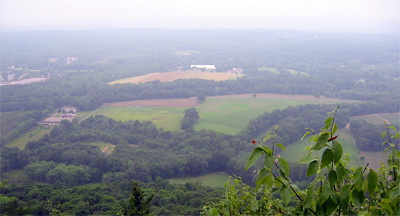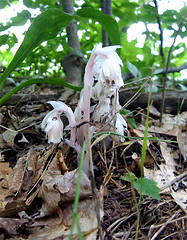Eco: Fungus Among Us
The walk up to the Heublein Tower, at Talcott Mountain State Park in Bloomfield/Simsbury, offers great views, a castle-like tower to explore, and on this day in mid-July, many kinds of fungus for mycology fans to enjoy. Fungi such as mushrooms belong to a kingdom of life all their own, one defined by their unique forms, growth patterns, reproduction, and the functions they perform in forest ecosystems.

Summer humidity helps bring out the best in mushrooms, but partially obscures the Heublein Tower Trail's famous views. On the day the boys and I were there it was so hot and humid that even the rocks were sweating.
Fungi grow cells in string-like filaments, and when conditions are right, produce masses of these cellular strands such as mushrooms. They play an essential role in helping to recycle nutrients in forests. Many actually secrete digestive enzymes that accelerate the decomposition of plant and animal remains, releasing carbon dioxide and minerals that are absorbed by living plants or returned to forest soils. Fungi also form symbiotic relationships with the roots of plants, increasing the roots' ability to absorb moisture and nutrients.


Along with mushrooms such as varieties of gilled mushroom like the one pictured above, we found plants commonly known as Indian pipe or more formally as Monotropa uniflora. This plant lacks chlorophyl, the green pigment usually found in photosynthetic plants. The fact that it grows on the forest floor along with many mushrooms, and the plant's white color can lead hikers to think it's a fungus, but Indian pipe's unique beauty is unmistakable.
The forests and soils of the Connecticut Valley's traprock ridges, such as those at Talcott Mountain and Penwood State Park, support many different kinds of fungus. The remains of ancient lava flows that flooded central Connecticut and parts of the northeast some 200 million years ago, these basalt ridges today stand hundreds of feet above the valley floor, and offer some of the best views and most enjoyable hikes in the state. All along the trail we found gilled mushrooms, bracket fungi growing on fallen limbs, puffballs, and more.
The ridges seem to stir something in humans as well, leading to the construction of observation towers at several high points in Connecticut, such as the one Gilbert Heublein had built here beginning in 1911. Others can be found atop Castle Craig in Meriden, and Sleeping Giant State Park in Hamden.

The Heublein Tower viewed from the picnic area, a great spot to sit and have lunch after hiking up, and ascending the tower to the observation room.
0 Comments:
Post a Comment
<< Home